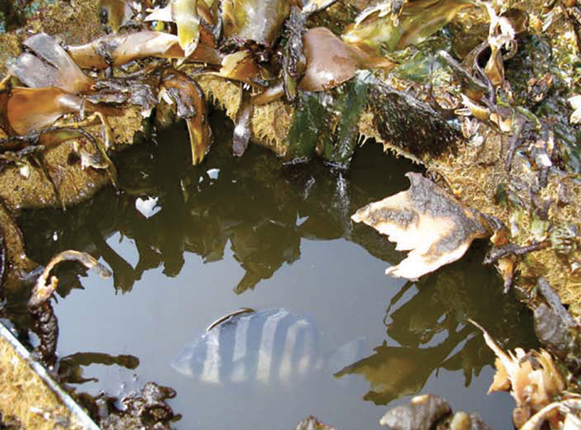Cruising the seas on the wreckage of a natural disaster
DOI: 10.1063/PT.3.3785
On 11 March 2011, a magnitude 9 earthquake off the east coast of Japan rocked the country’s Tohoku region and generated tsunami waves with heights reaching 40 meters. In the ensuing days, buoys, fishing vessels, four large fisheries docks, and more were launched into the Pacific Ocean. The provenance of that detritus can be determined from explicit markings and other, more subtle forensic clues. And now a team led by James Carlton of Williams College has documented that the debris has carried at least 289 living species—including mollusks, crustaceans, and fish—from Japan to the Hawaiian Islands and the Pacific coast of North America; the photo shows one arrival, a barred knifejaw fish stowed in the stern well of a fishing vessel from the Iwate prefecture. Indeed, new species have continued to arrive at least up until February of this year, the most recent date considered by Carlton and company.

NANCY TRENEMAN

Organisms have long hitched rides across the seas in or on commercial vessels, but the research team emphasizes that a chunk of debris is a qualitatively different conveyance. Its slower speed enables a richer variety of species to more successfully cling to the surface. And organisms on a leisurely raft ride across the ocean can better acclimate to changing environmental conditions.
The tremendous trans-Pacific migration appears to be without precedent. Japan endured Tohoku-scale tsunamis in 1896 and 1933, but Carlton’s team could find no reports of Japanese debris washing up on North American shores. The researchers note that in those days, port regions didn’t use fiberglass, polystyrene foam, and other nonbiodegradable materials common today. Twenty-first-century rubbish rafts are better at surviving the harsh conditions of an ocean voyage without falling apart.
As far as is known, say the researchers, none of the seafaring organisms from Japan have proliferated enough to become invasive. But it is too early to sound the all clear; often years elapse before an invasion can be detected. (J. T. Carlton et al., Science 357, 1402, 2017; doi:10.1126/science.aao1498
